Content
- Possible reasons
- Caries
- Trauma
- Special sensitivity of teeth
- Pulpitis
- Gingivitis
- Periodontitis
- ARVI, sinusitis, sinusitis
- Treatment methods
- Treatment of pain caused by tooth decay
- Pulpitis treatment
- Teeth trauma therapy
- Periodontitis treatment
- Gingivitis therapy
- Pulpitis treatment
- ARVI treatment
- Possible consequences and complications
- Tooth Pain Videos
Toothache is an unpleasant discomfort, which can be relieved by painkillers, but this is only temporary, after a while it will still return. That is why if a similar symptom is observed in the area of the anterior upper jaw, then it is necessary to consult a dentist. Even under minor discomfort, a serious ailment can be hidden, so if a symptom appears, you need to react immediately.
Possible reasons
Despite the fact that almost all teeth have the same internal structure, it is the incisors that are most often injured. In the front teeth, the thinnest layer of dentin is the bone tissue, of which the tooth is mainly composed. It is because of this feature that caries develops more actively on the front teeth.
The front teeth of the upper jaw hurt for various reasons and some of them provoke serious illnesses, therefore, for any discomfort, it is important to consult a specialist.
Caries
Carious formations on the front teeth do not appear in an instant, this is a rather slow process and it is connected with the fact that pathogenic bacteria live in plaque on the teeth, which actively develop in a humid environment and make enamel weaker. Destroyed enamel is an excellent passage for microbes inside the tooth, where the pathological process actively multiplies, affecting healthy tissues.
Pain in the front teeth of the upper or lower jaw due to caries is observed only in the late stage of the disease, when the microbes have already got inside, have struck the pulp and the nerve process. That is why pain is an alarming symptom that should make a person urgently go to the dentist for help.
Caries most often occurs in people who do not follow oral hygiene, but also due to other reasons:
- lack of minerals in the diet;
- lack of solid food;
- hereditary factor;
- systemic pathology that disrupt metabolic processes in the body;
- trauma to the teeth.
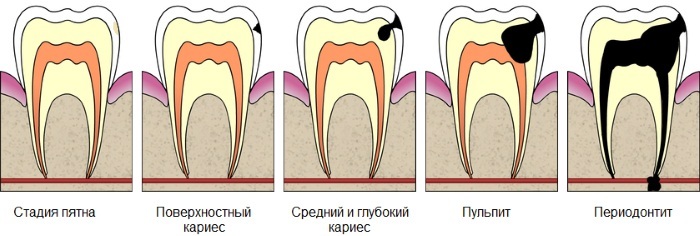
If a person has a predisposition to the development of caries, then you need to take it as a habit - to visit the dentist din once every six months for preventive purposes.
Trauma
More often the teeth of the upper jaw are injured due to household, street, sports and industrial injuries. If this is just a bruise, then the pain is insignificant and after a couple of days it completely disappears. But the fracture is accompanied by severe pain in the upper jaw, in the area under the eye. Swelling and hemorrhage are also observed. Nasal breathing is very difficult.
Tooth injuries are dangerous because of their cracks, through which microbes can easily penetrate into the very depths of the tooth. That is why it is important to consult a dentist in a timely manner.
Special sensitivity of teeth
An intense tooth reaction to hot, sweet or cold foods is a sign of enamel thinning. The reasons for this feature may be a lack of minerals or pathologies that affect metabolic processes. If sensitivity is observed, then you should go to a specialist to find out the cause and prevent the development of complications.
Pulpitis
This is an inflammatory process that affects the neurovascular bundle located inside the tooth. The pulp swells and touches the walls of the chamber, there is pressure on the nerve endings and, as a result, pain. This pain gets worse every day. The cause of the development of pulpitis is caries, which is actively progressing due to inactivity.
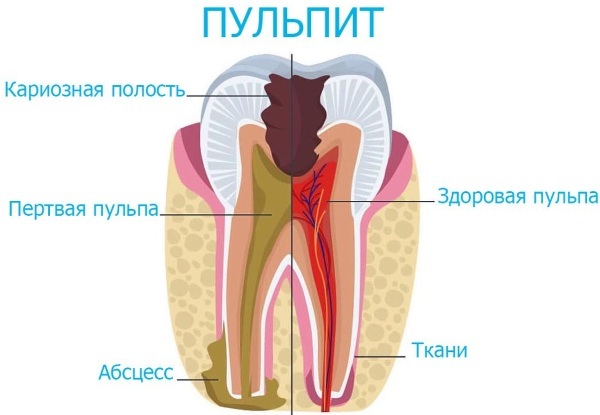
Microbes, toxins and other harmful substances easily penetrate the tooth and damage the nerve, having a negative effect on the tissues.
Gingivitis
The front teeth of the upper jaw sometimes hurt due to the developing inflammation of the gums. The gums can suffer from the active development of periodontal disease or periodontitis. With such pathologies, in addition to pain, bleeding of the gums is also observed, and discomfort is felt when chewing food. Such diseases can provoke exposure of the roots of the tooth, which explains the special sensitivity. If the process develops actively, then bacteria quickly penetrate deep into the tooth, affecting the pulp, which ultimately leads to tooth loss.
Periodontitis
The front teeth of the upper jaw also hurt due to inflammation of the tissues around the tooth. A dead pulp remains inside the canal of the tooth, and its purulent contents flow into the gums, which provokes severe pain, which does not even allow touching the tooth. With periodontitis, it is difficult for the patient to chew food, eat hot and cold dishes.
ARVI, sinusitis, sinusitis
Bacterial and viral pathologies affect the mucous membrane of not only the nose, but are also very dangerous for the upper front teeth. As a result, there may be discomfort in the teeth. A similar situation is also observed with the lower jaw, if only a person has a sore throat or pharyngitis.
Treatment methods
The front teeth of the upper jaw hurt for a long time - this means that you need to seek help from a dentist. You can take an anesthetic medication, but if the problem is serious, the relief will be temporary, and then the pain will return again.
If suddenly, for some reason, you cannot get to the doctor right away, then there are several ways that will help alleviate the condition:
- You can rinse your mouth with a baking soda solution. To prepare a useful solution, you will need to take 2 tbsp. warm water and add 1 tsp. l. soda. Rinse your mouth with a soda solution until the discomfort goes away.

- You can attach a clove of garlic to your teeth by cutting it in half.
- A cold compress should be applied to the affected area.
- Take a tincture of valerian and calendula, mix in a 1: 1 ratio. In the resulting solution, moisten a cotton pad and apply to the sore spot.
- Take a small piece of gauze, sprinkle a pinch of salt and ground black pepper on it, apply to the gums.
- Areas with discomfort can be smeared with beet juice.
All the methods described will only help relieve discomfort for a while. They are not therapeutic methods, so you should contact your dentist as soon as possible.
Treatment of pain caused by tooth decay
Caries treatment involves a step-by-step solution to the problem. During the treatment, the dentist removes all affected areas of the tooth with a drill. And then the shape of the tooth is restored with a filling. All stages of treatment are described in the table below.
| Removal of dental plaque | You need to start treatment with a hygienic procedure - plaque and tartar are removed. Special brushes and abrasive pastes will help to cope with this task. |
| Tooth shade determination | Hygienic cleaning will help you choose the right color for your filling. It will blend perfectly with the tooth and not stand out from its background. |
| Anesthesia | Drilling out a tooth can be uncomfortable, so the specialist recommends using anesthesia. An injection with Ultracaine or Ubistezine helps to quickly relieve pain and carry out the procedure painlessly. |
| Drilling out carious tissue | Enamel is less likely to be destroyed, more often dentin suffers from caries. The thing is that the enamel is much stronger and harder than dentin. A carious hole inside a tooth can be large, and the entrance is completely invisible. The dentist must open the tooth and drill out the enamel over the caries. |
| Isolation from saliva | This stage is very important. After the carious tissues are removed, the tooth must be isolated from saliva before filling. Previously, the tooth was simply covered with cotton balls, but today a rubber dam is used - this is a latex scarf in which a hole is made for the tooth. The scarf is applied to the aching tooth and then fixed with a special frame. |
| Treatment of carious cavity with medicines | Treat the entire tooth cavity with an antiseptic. |
| Restoration of contact of a tooth with others in a row | If caries provoked the destruction of the tooth wall, then it must be restored using special devices: wedges or a matrix. |
| Acid pickling | This step is necessary in order to improve the adhesion between the tooth and the filling. For this purpose, a phosphoric acid gel is used. When the etching is over, all the residues of the gel are washed off, and the surface of the tooth is dried. |
| Adhesive treatment | To improve the fixation of the filling, the enamel and dentin are treated with adhesive, which is polymerized with a special lamp. |
| Applying a gasket under the seal | It is usually made of glass ionomer cement. Such a gasket is necessary in order to remove all negative moments of filling shrinkage. |
| Filling | The filling helps to restore the shape of the tooth, chewing function. For these purposes, a photopolymer composite is used. It is applied in layers and each layer is illuminated with a lamp. |
| Tooth grinding | After the filling is applied, the surface of the tooth must be ground to remove all the irregularities of the filling. |
Pulpitis treatment
Pain relievers will help to quickly relieve pain. For example, you can drink Nimid powder, the active substance of which is Nimesudide. The drug is diluted before use in ½ tbsp. water and drink. You can take it no more than 4 times a day. But this drug will only remove the symptom - pain, and only a dentist can cure the disease.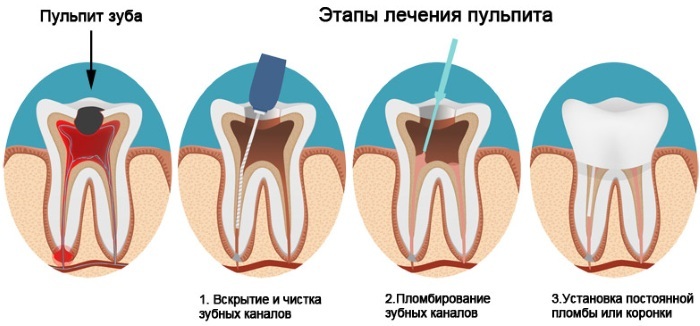
A dentist with pulpitis will take the following treatment regimen:
- uses anesthesia to relieve pain in the affected area;
- opens the pulp chamber;
- removes the nerve;
- cleans canals in the root area;
- flushes the canals and seals them;
- sets fillings on the crown.
After treatment, your dentist may recommend antibiotics to relieve the effects of inflammation. A good remedy is the drug Amoxiclav, which is produced in the form of tablets and contains amoxicillin and clavulanic acid as an active component. It effectively deals with many pathogenic microorganisms. Take it 500 mg twice a day, the course is not more than 5 days.
Teeth trauma therapy
If a bruise was diagnosed, then in this case, the patient needs to adhere to a diet for 2 weeks in order to reduce the load on the diseased tooth. It is imperative to take a snapshot to determine if the pulp is damaged. Chips on the enamel, broken horses, damage to the pulp - all these problems are called a fracture of the tooth.
If a milk tooth is damaged, then it is simply removed. Specialists try to restore a permanent tooth using restoration or canal therapy. If a tooth has crumbled during injury, then it is worth immediately collecting the fragments, lowering them into milk and going to the dentist. He can collect the tooth and all the fragments will easily take root.
If it was not possible to collect the fragments, then the specialist adheres to the following treatment regimen:
- with minor damage, the damaged tooth can be restored with a filling;
- if the tooth is severely damaged, then the dentist conducts endodontic therapy to preserve the pulp, and a crown is installed on the donkey;
- if a tooth root is broken, a hard splint is placed on it for 4 months, periodically observing the condition of the pulp, and then the tooth is restored with the help of pins.
Periodontitis treatment
This ailment can be treated in several ways: therapeutic, surgical and combined.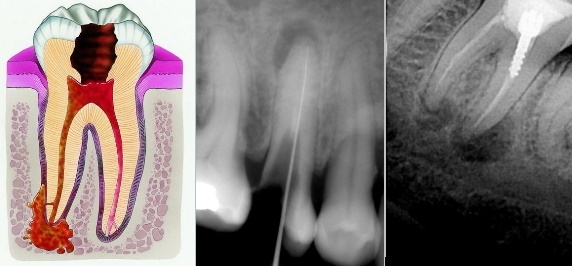
The therapeutic method includes:
- the introduction of pain relief;
- isolation of the tooth;
- tooth creation: removal of hard tooth tissue or filling that closes the entrance to the tooth;
- creation of a root canal;
- introduction of drugs into the channel;
- canal filling;
- restoration of the anatomy and functions of the tooth.
Surgical treatment includes the following options:
- removing part of the root;
- completely removing the entire root;
- removal of the entire tooth.
Gingivitis therapy
For therapy to be successful, inflammation must be eliminated. For this, plaque and tartar are removed.
To relieve inflammation, drugs such as:
-
Metronidazole. This drug is available in the form of tablets, which contain a substance of the same name as an active ingredient. This drug has pronounced antibacterial properties. The active substance has the peculiarity of easily penetrating the bacteria and destroying it, preventing it from multiplying. Take the drug 1 tablet twice a day for about 5-7 days.

- Infusion of sage and chamomile. Take the herb, mix and select 1 tbsp. l. collection. Pour a glass of boiling water and rinse the mouth 3-4 times a day.
If the inflammation is accompanied by severe pain, then the specialist adds painkillers to the therapy.
Pulpitis treatment
Pulpitis treatment involves the following stages:
- Initially, the dentist must administer an anesthetic. The thing is that the further stages are quite painful.
- Removal of tissues damaged by caries. Pulpitis is a complication after untreated caries, therefore, all tissues damaged by caries must be removed first.
- Then the dentist proceeds to cure the pulp. A special instrument is used to remove the pulp.
- When the pulp is removed, the canals are cleaned, a temporary filling is installed.
- Further, the filling of the canals is carried out.
- Installation of a permanent seal.
Only a specialist can carry out the treatment.
ARVI treatment
If the dentist examined the patient and found out that the pain in the teeth is not his problem, but the ENT, then he can recommend visiting a specialist so that he chooses the right treatment that will not cause any discomfort.
Possible consequences and complications
The front teeth of the upper jaw hurt for a long time, and no measures other than taking painkillers have been taken, then complications will not be long in coming. And the main problem is not the aesthetics of a smile, but serious ailments that have affected the internal organs.
According to dentists, rotten and inflamed teeth can be the reason for the active development of such pathologies in the body as:
- arthritis;
- arthrosis;
- polyarthritis.
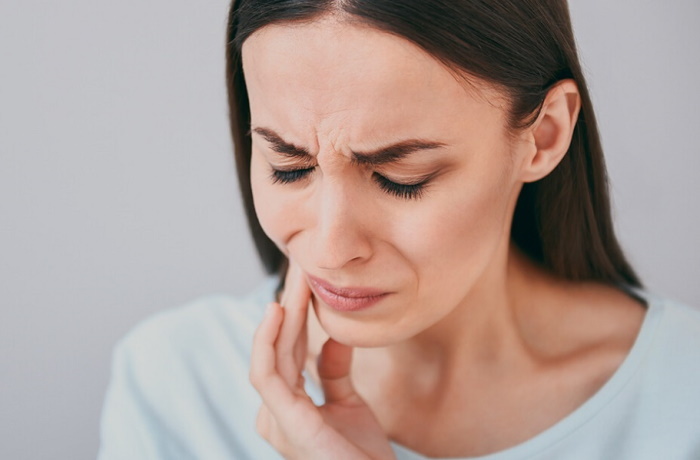
The front teeth of the upper jaw hurt
Microbes that cause tooth decay can easily seep into the body through saliva or through the circulatory system. And as a result, a person begins to show problems with the functions of internal systems. The infection can spread throughout the body at an incredible rate, affecting not only bone tissue, but also the brain. Failure to act can lead to disability or even death.
Front teeth hurt - this is only a symptom, not a separate disease. It is very important to find out what is the cause of the discomfort, since this symptom may indicate the development of a serious ailment. The upper jaw, like the lower one, is connected with other parts of the face, so pain can indicate different types of pathologies. Initially, it is worth visiting the dentist, and after the examination, he will tell him exactly this is a problem or refer him to another specialist.
Tooth Pain Videos
Malysheva about toothache not from teeth:
